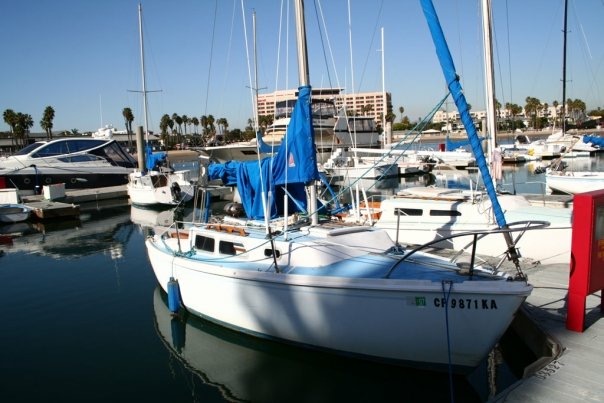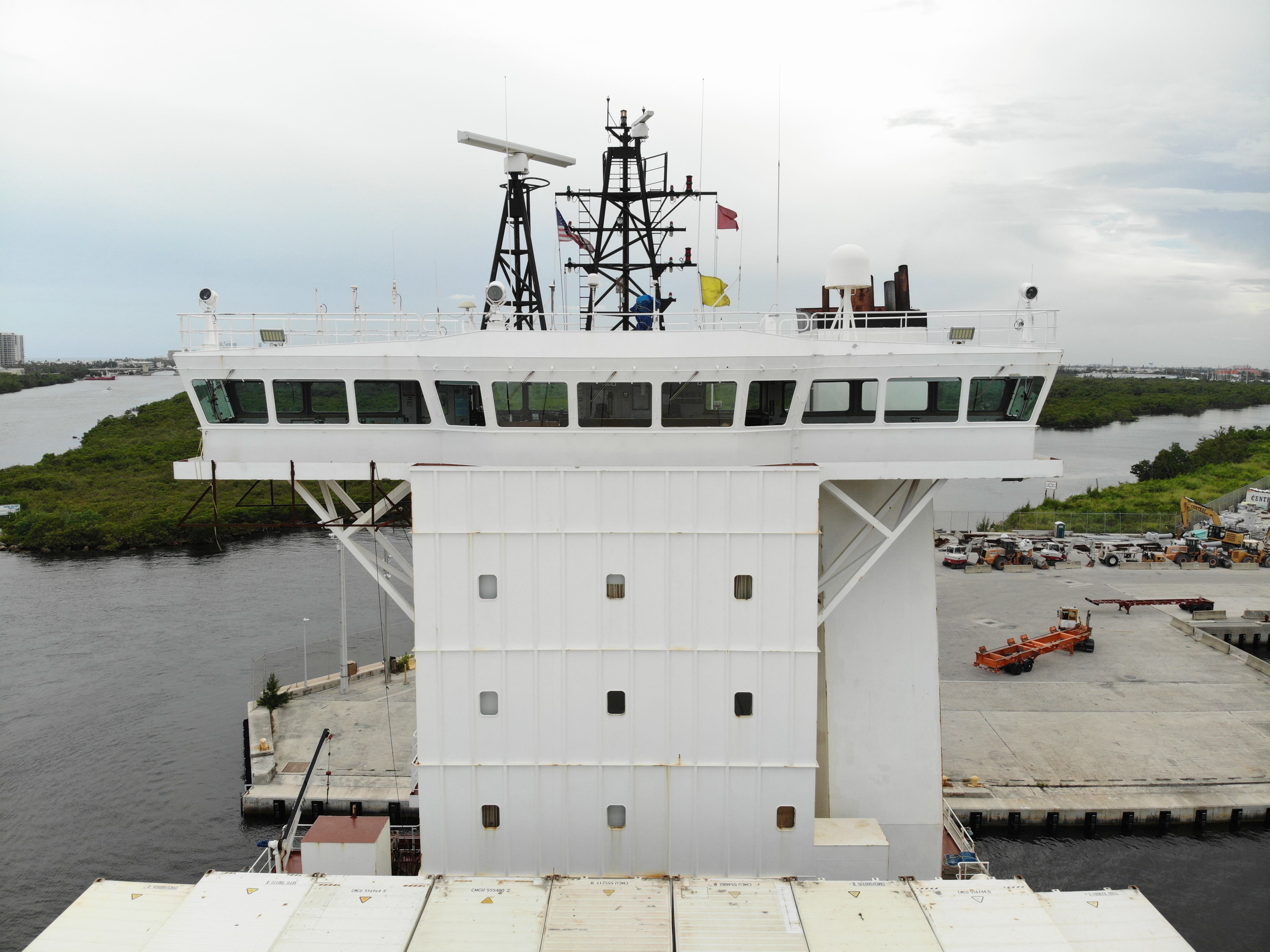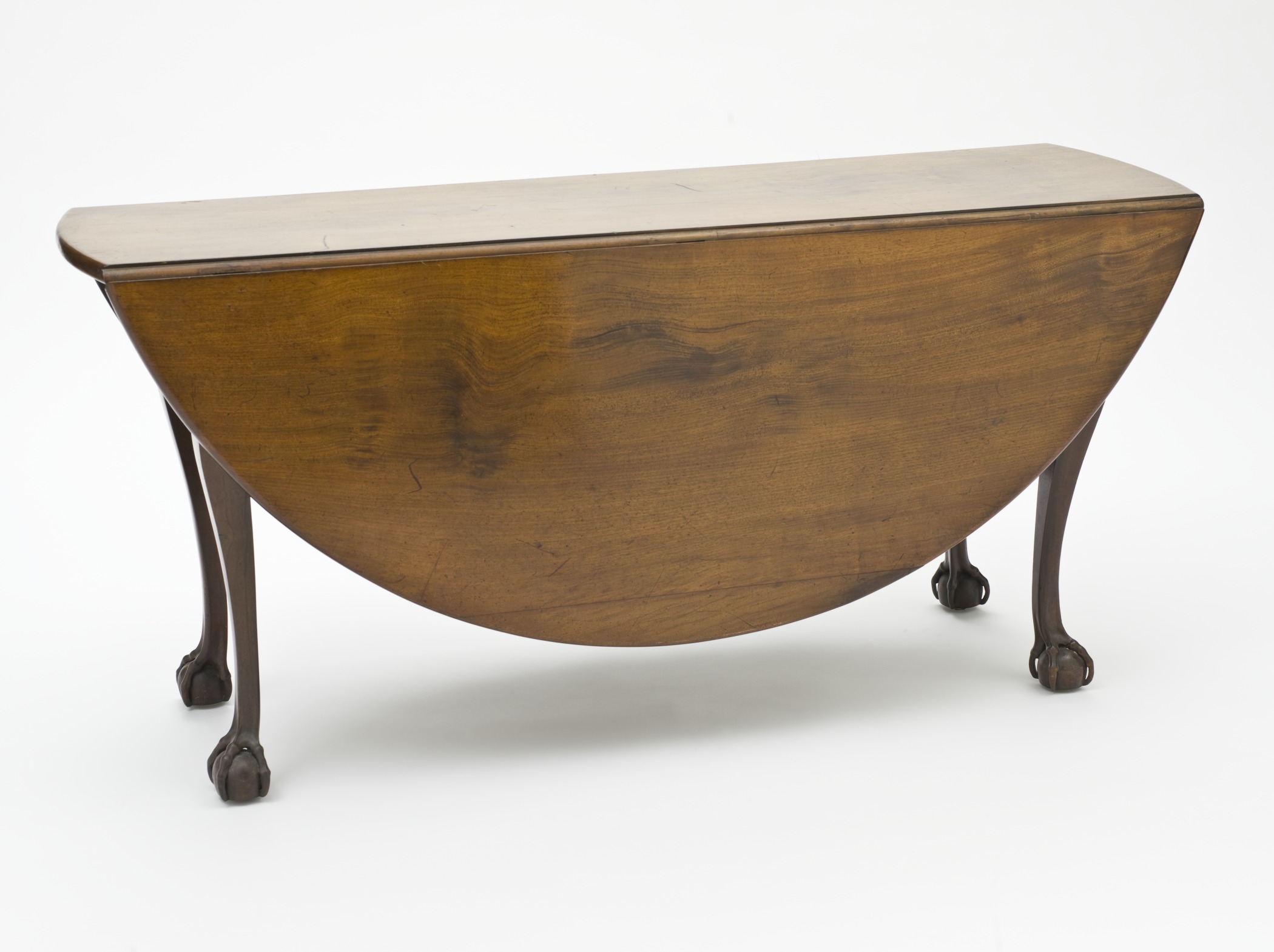|
Gulf 27
The Gulf 27 is an American sailboat that was designed by Capital Yachts as a cruiser and first built in 1970. The design was mostly likely the basis for the extended Gulf 29, introduced in 1982. Production The design was built by Capital Yachts in Harbor City, California, United States, starting in 1970, but it is now out of production. Design The Gulf 27 is a recreational keelboat, built predominantly of fiberglass, with wood trim. It has a masthead sloop rig, a raked stem, a plumb transom, an internally mounted spade-type rudder controlled by two wheels, one in the cockpit and one in the pilot house and a fixed fin keel. It displaces and carries of ballast. The boat has a draft of with the standard keel and is fitted with a two-cylinder diesel engine for docking and maneuvering. The design has sleeping accommodation for three people, with a double "V"-berth in the bow cabin and a straight settee in the main cabin, next to a drop-leaf table. The galley is located on ... [...More Info...] [...Related Items...] OR: [Wikipedia] [Google] [Baidu] |
Capital Yachts
Capital Yachts Corporation, also called Capital Yachts, Inc. was an American boat builder based in Harbor City, California. The company operated as a division of Lindsey Plastics and specialized in the design and manufacture of fiberglass sailboats.Henkel, Steve: ''The Sailor's Book of Small Cruising Sailboats'', pages 47 & 299. International Marine/McGraw-Hill, 2010. History The company was founded by Jon Williams and Bill Smith in 1971 when they purchased the tooling for the Newport series of boats from Elgin National Industries of New York, who owned Newport Boats. Capital Yachts put the Newport series back into production and also had new boats designed by American naval architect Gary Mull and the Canada, Canadian design firm of Cuthbertson & Cassian, famous for the C&C Yachts series. Williams and Smith had their start as sailboat dealers in the area of Santa Monica, California, before moving into manufacturing. The company produced boats in three marketing lines: Gulf, N ... [...More Info...] [...Related Items...] OR: [Wikipedia] [Google] [Baidu] |
Pilot House
The interior of the bridge of the Sikuliaq'', docked in Ketchikan, Alaska file:Wheelhouse of Leao Dos Mares.jpg, Wheelhouse on a tugboat, topped with a flying bridge The bridge, also known as the pilothouse or wheelhouse, is a room or platform of a ship from which the ship can be commanded. When a ship is under way, the bridge is manned by an officer of the watch aided usually by an able seaman acting as a lookout. During critical maneuvers the captain will be on the bridge, often supported by an officer of the watch, an able seaman on the wheel and sometimes a pilot, if required. History and etymology The compass platform of a British destroyer in the Second_World_War.html" ;"title="Battle of the Atlantic during the Second World War">Battle of the Atlantic during the Second World War with central binnacle and the voice pipes to belowdecks There are many terms for parts of a ship with functions similar to a bridge. Depending upon the design and layout of a ship, some of ... [...More Info...] [...Related Items...] OR: [Wikipedia] [Google] [Baidu] |
Sailing Yachts
A sailing yacht (US ship prefixes SY or S/Y), is a leisure craft that uses sails as its primary means of propulsion. A yacht may be a sail or power vessel used for pleasure, cruising, or racing. There is no standard definition, so the term applies here to sailing vessels that have a cabin with amenities that accommodate overnight use. To be termed a "yacht", as opposed to a "boat", such a vessel is likely to be at least in length and have been judged to have good aesthetic qualities. Sailboats that do not accommodate overnight use or are smaller than are not universally called yachts. Sailing yachts in excess of are generally considered to be superyachts. Sailing yachts are actively used in sport and are among categories recognized by the governing body of sailing sports, World Sailing. Etymology The term ''yacht'' originates from the Dutch word ''jacht'' (pl. ''jachten'', which means "hunt"), and originally referred to light, fast sailing vessels that the Dutch Republic na ... [...More Info...] [...Related Items...] OR: [Wikipedia] [Google] [Baidu] |
1970s Sailboat Type Designs
Year 197 ( CXCVII) was a common year starting on Saturday (link will display the full calendar) of the Julian calendar. At the time, it was known as the Year of the Consulship of Magius and Rufinus (or, less frequently, year 950 ''Ab urbe condita''). The denomination 197 for this year has been used since the early medieval period, when the Anno Domini calendar era became the prevalent method in Europe for naming years. Events By place Roman Empire * February 19 – Battle of Lugdunum: Emperor Septimius Severus defeats the self-proclaimed emperor Clodius Albinus at Lugdunum (modern Lyon). Albinus commits suicide; legionaries sack the town. * Septimius Severus returns to Rome and has about 30 of Albinus's supporters in the Senate executed. After his victory he declares himself the adopted son of the late Marcus Aurelius. * Septimius Severus forms new naval units, manning all the triremes in Italy with heavily armed troops for war in the East. His soldiers embark on ... [...More Info...] [...Related Items...] OR: [Wikipedia] [Google] [Baidu] |
Keelboats
A keelboat is a riverine cargo-capable working boat, or a small- to mid-sized recreational sailing yacht. The boats in the first category have shallow structural keels, and are nearly flat-bottomed and often used leeboards if forced in open water, while modern recreational keelboats have prominent fixed fin keels, and considerable draft. The two terms may draw from cognate words with different final meaning. A keep boat, keelboat, or keel-boat is a type of usually long, narrow cigar-shaped riverboat, or unsheltered water barge which is sometimes also called a poleboat—that is built about a slight keel and is designed as a boat built for the navigation of rivers, shallow lakes, and sometimes canals that were commonly used in America including use in great numbers by settlers making their way west in the century-plus of wide-open western American frontiers. They were also used extensively for transporting cargo to market, and for exploration and trading expeditions, for w ... [...More Info...] [...Related Items...] OR: [Wikipedia] [Google] [Baidu] |
List Of Sailing Boat Types
The following is a partial list of sailboat types and sailing classes, including keelboats, dinghies and multihull ( catamarans and trimarans). Olympic classes World Sailing Classes Historically known as the IYRU (International Yacht Racing Union), the organization evolved into the ISAF (International Sailing Federation) in 1996, and as of December 2015 is now World Sailing. Dinghies Keelboats & yachts Multihulls Boards Radio-controlled Former World Sailing-classes Dinghies Keelboats & yachts Multihulls Boards Other classes and sailboat types Dinghies Keelboats & yachts Multihulls See also * Classic dinghy classes * List of boat types * List of historical ship types * List of keelboat classes designed before 1970 * Olympic sailing classes * Small-craft sailing * Clansman 30 Notes References {{DEFAULTSORT:Sailing boat types Types * Boat types A boat is a watercraft of a large range of types and sizes, but ge ... [...More Info...] [...Related Items...] OR: [Wikipedia] [Google] [Baidu] |
Hull Speed
Hull speed or displacement speed is the speed at which the wavelength of a vessel's bow wave is equal to the waterline length of the vessel. As boat speed increases from rest, the wavelength of the bow wave increases, and usually its crest-to-trough dimension (height) increases as well. When hull speed is exceeded, a vessel in displacement mode will appear to be climbing up the back of its bow wave. From a technical perspective, at hull speed the bow and stern waves interfere constructively, creating relatively large waves, and thus a relatively large value of wave drag. Ship drag for a displacement hull increases smoothly with speed as hull speed is approached and exceeded, often with no noticeable inflection at hull speed. The concept of hull speed is not used in modern naval architecture, where considerations of speed/length ratio or Froude number are considered more helpful. Background As a ship moves in the water, it creates standing waves that oppose its movement. T ... [...More Info...] [...Related Items...] OR: [Wikipedia] [Google] [Baidu] |
Head (watercraft)
The head (pl. heads) is a ship's toilet. The name derives from sailing ships in which the toilet area for the regular sailors was placed at the head or bow of the ship. Design In sailing ships, the toilet was placed in the bow somewhat above the water line with vents or slots cut near the floor level allowing normal wave action to wash out the facility. Only the captain had a private toilet near his quarters, at the stern of the ship in the quarter gallery. The plans of 18th-century naval ships do not reveal the construction of toilet facilities when the ships were first built. The Journal of Aaron Thomas aboard HMS ''Lapwing'' in the Caribbean Sea in the 1790s records that a canvas tube was attached, presumably by the ship's sailmaker, to a superstructure beside the bowsprit near the figurehead, ending just above the normal waterline. In many modern boats, the heads look similar to seated flush toilets but use a system of valves and pumps that brings sea water into the toi ... [...More Info...] [...Related Items...] OR: [Wikipedia] [Google] [Baidu] |
Ice Box
An icebox (also called a cold closet) is a compact non-mechanical refrigerator which was a common early-twentieth-century kitchen appliance before the development of safely powered refrigeration devices. Before the development of electric refrigerators, iceboxes were referred to by the public as "refrigerators". Only after the invention of the modern day electric refrigerator did early non-electric refrigerators become known as iceboxes. The terms ''ice box'' and ''refrigerator'' were used interchangeably in advertising as long ago as 1848. Origin The first recorded use of refrigeration technology dates back to 1775 BC in the Sumerian city of Terqa. It was there that the region's King, Zimri-lim, began the construction of an elaborate ice house fitted with a sophisticated drainage system and shallow pools to freeze water in the night. Using ice for cooling and preservation was nothing new at this point, but these ice houses paved the way for their smaller counterpart, the iceb ... [...More Info...] [...Related Items...] OR: [Wikipedia] [Google] [Baidu] |
Companionway
In the architecture of a ship, a companion or companionway is a raised and windowed hatchway in the ship's deck (ship), deck, with a ladder leading below and the hooded entrance-hatch to the main cabins. A companionway may be secured by doors or, commonly in sailboats, ''hatch boards'' which fit in grooves in the companionway frame. This allows the lowest board to be left in place during inclement weather to minimize water infiltration. The term may be more broadly used to describe any ladder between decks. File:Hatchboards.JPG, Set of hatch boards in companionway hatch. File:Hatchboards2.JPG, Set of hatch boards with top board removed. See also Glossary of nautical terms References {{sailing ship elements Rooms Water transport Nautical terminology ... [...More Info...] [...Related Items...] OR: [Wikipedia] [Google] [Baidu] |
Galley (kitchen)
The galley is the compartment of a ship, train, or aircraft where food is cooked and prepared. It can also refer to a land-based kitchen on a naval base, or, from a kitchen design point of view, to a straight design of the kitchen layout. Ship's cooking area A galley is the cooking area aboard a vessel, usually laid out in an efficient typical style with longitudinal units and overhead cabinets. This makes the best use of the usually limited space aboard ships. It also caters for the rolling and heaving nature of ships, making them more resistant to the effects of the movement of the ship. For this reason galley stoves are often gimballed, so that the liquid in pans does not spill out. They are also commonly equipped with bars, preventing the cook from falling against the hot stove. A small cooking area on deck was called a caboose or ''camboose'', originating from the nl, kombuis, which is still in use today. In English it is a defunct term used only for a cooking area that i ... [...More Info...] [...Related Items...] OR: [Wikipedia] [Google] [Baidu] |
Drop-leaf Table
A drop-leaf table is a table that has a fixed section in the center and a hinged section (leaf) on either side that can be folded down (dropped). If the leaf is supported by a bracket when folded up, the table is simply a drop-leaf table; if the leaf is supported by legs that swing out from the center, it is known as a gateleg table. Depending on the style of drop-leaf or gateleg tables, the leaves vary from coming almost down to the floor to only coming down slightly. The usual purpose of a drop-leaf table is to save space when the table is not in use. Typical examples of drop-leaf tables are: dining tables, night stands, side tables, coffee tables, and desks. Drop-leaf tables were found mostly in England where they date back to the late sixteenth century; Elizabethan era and Jacobean era examples are still extant. References Tables (furniture) {{furniture-stub ... [...More Info...] [...Related Items...] OR: [Wikipedia] [Google] [Baidu] |








